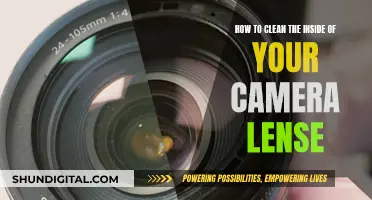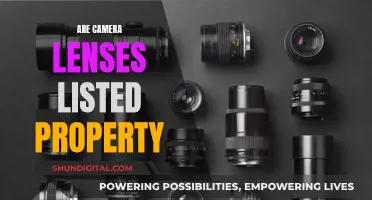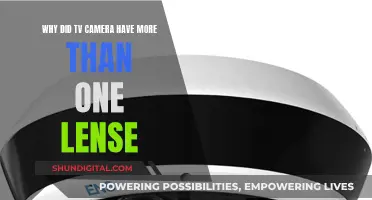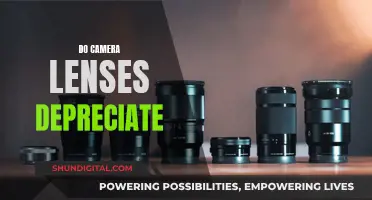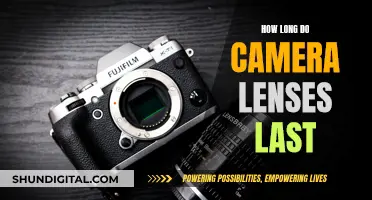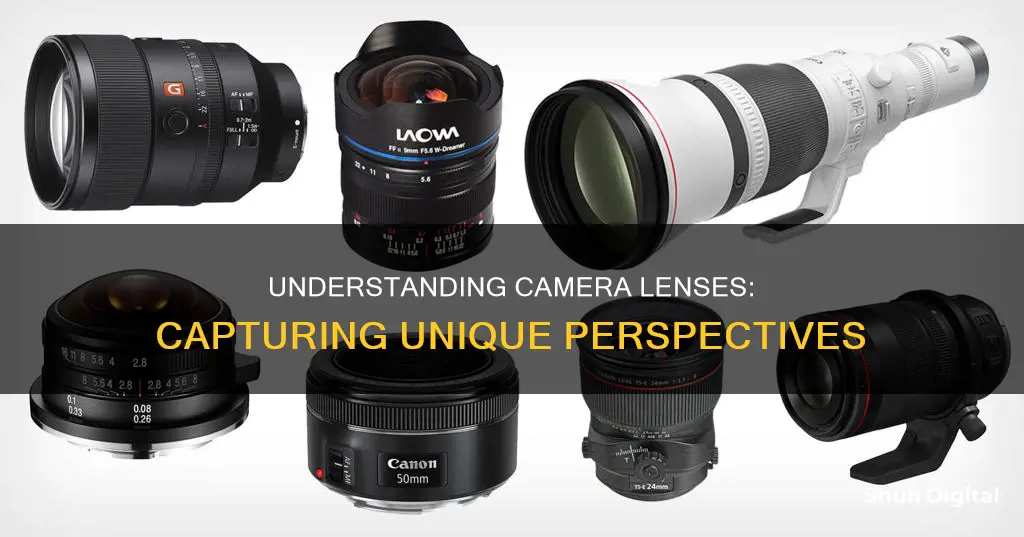
Camera lenses are essential for photographers, as they direct light and determine how much light passes through to the camera sensor or film. The main difference between camera lenses is their focal length, which refers to the distance between the focal point and the sensor. Lenses with shorter focal lengths, such as wide-angle lenses, offer a wider field of view, while those with longer focal lengths, like telephoto lenses, provide greater magnification but a narrower field of view. In addition to focal length, lenses also vary in terms of their maximum aperture, their ability to focus closely, and features like image stabilisation.
| Characteristics | Values |
|---|---|
| Purpose | Capturing light and focusing it into a tiny spot on the back of a camera to produce an image |
| Types | Prime, Zoom, Standard, Wide-angle, Telephoto, Super-telephoto, Macro, Tilt-shift, Ultra-wide-angle, Fisheye |
| Focal Length | The distance between the focal point and the sensor |
| Focal Length Range | Prime: Fixed; Zoom: Variable within a range, e.g. 16-35mm |
| Aperture | The size of the lens opening, measured in f-stops, e.g. f/2.8, f/4 |
| Depth of Field | How much of the scene is in focus once correct lens focusing is achieved |
| Image Stabilisation | Motor-controlled glass elements reduce vibration and shake |
| Weight | Prime lenses are generally lighter than zoom lenses |
| Cost | Prime lenses are generally cheaper than zoom lenses |
| Flexibility | Zoom lenses offer more flexibility by allowing variable focal lengths |
| Versatility | Prime lenses are less versatile as they have a fixed focal length |
| Usage | Depends on the type of photography, e.g. wildlife, sports, portrait, landscape |
What You'll Learn

Prime vs Zoom lenses
Prime lenses have a fixed focal length, whereas zoom lenses offer a range of focal lengths that can be adjusted by turning the zoom ring. Zoom lenses are therefore more versatile and convenient, allowing photographers to quickly adjust their angle of view without having to move. Prime lenses, on the other hand, require photographers to "zoom with their feet", meaning they must physically move closer to or further from their subject to adjust the shot. This can be a more intuitive way of shooting for some photographers, and it can also help to improve their composition skills.
Prime lenses are generally smaller, lighter, and cheaper than zoom lenses, as they have fewer moving parts. They also tend to offer better optical quality, with sharper images and a larger maximum aperture, resulting in better low-light performance and "bokeh" (background blur). Zoom lenses, on the other hand, often suffer from reduced sharpness near their maximum focal length and typically have a smaller maximum aperture, which can make it more difficult to achieve a shallow depth of field.
While prime lenses offer superior image quality, zoom lenses provide greater flexibility and convenience, making them a popular choice for photographers who need to adapt to a variety of shooting situations.
Sigma Lenses: Blackmagic Cinema Camera Compatibility Guide
You may want to see also

Standard/normal lenses
Standard or normal lenses are those that produce images that roughly match what the human eye sees, giving photos a natural feel. They are versatile and produce excellent image quality. They are called "normal" lenses because they aim to capture a shot in a way that is most similar to how we see the world. They have a focal length of between 35mm and 85mm, although the most common standard lens is 50mm. This focal length is most similar to the angle of view of the human eye, which is around 50 to 55 degrees diagonally. This is why standard lenses give a natural-looking perspective.
Standard lenses are great general-purpose lenses and can be used to photograph everything from close-up portraits to landscapes. They are particularly good for candid photos, where the photographer wants to include some surrounding scenery to put the subject in context. They are also very "fast" lenses, meaning they have a wide aperture, making them great for indoor and low-light photography.
Standard lenses are "prime" lenses, meaning they have a fixed focal length. This means they cannot zoom in or out, but they make up for this with superior optical quality and wide apertures. This allows them to capture stunning images in a wide range of situations and lighting conditions.
Standard lenses used to be very common, and most photographers started off with one. However, nowadays they are not as common, as manufacturers tend to bundle cameras with cheap zoom lenses. Despite this, standard lenses are still an excellent addition to any photographer's kit, offering versatility, excellent image quality, and the ability to capture natural-looking images.
Lens Filters: Capturing Unique Camera Perspectives
You may want to see also

Telephoto lenses
Due to their long focal lengths, telephoto lenses are significantly heavier and bulkier than other types of lenses, often requiring the use of accessories like tripods or monopods for support. They inherently produce very narrow focal planes due to the inverse relationship between depth of field and focal length.
While telephoto lenses offer the advantage of distance photography, they also come with some challenges. Their weight and size can make them impractical for certain situations, and the narrow focal planes can result in atmospheric haze and a "mirage" effect that causes blurriness in images.
Despite these considerations, telephoto lenses remain a valuable tool for photographers, especially those specialising in wildlife, sports, or nature photography, allowing them to capture sharp and detailed images from a distance.
Camera Lenses Lifespan: How Long Can You Expect Them to Last?
You may want to see also

Wide-angle lenses
However, a wide lens can hinder your photos in some cases. Portrait photographers usually opt for a higher focal length to avoid the unflattering distortion that comes with wider lenses. A telephoto lens is usually the best choice for sports and wildlife photography, or any time you need to get close to the action.
Another result of using a wide-angle lens is the apparent perspective distortion when the camera is not aligned perpendicularly to the subject. For example, buildings appear to fall backward when the camera is pointed upward from ground level.
There are two varieties of wide-angle lens: short-focus lenses and retrofocus lenses. Short-focus lenses are generally made up of multiple glass elements whose shapes are more or less symmetrical in front of and behind the diaphragm. The retrofocus lens has an asymmetrical design that allows the rear element to be farther away from the film plane than its effective focal length would suggest.
Vintage Camera Lenses: Worth the Money or Not?
You may want to see also

Macro lenses
The purpose of a macro lens is to display subjects at life-size (1:1) or larger. This is achieved through a specific optical construction that enables the dramatic magnification of small subjects. They are also designed to focus at close distances, helping to blur the background and provide a flat plane of focus that reduces softness in the corners.
When choosing a macro lens, consider the type of subject you will be photographing. Longer focal lengths, such as 90-105mm, are ideal for insects, flowers, and small objects, as they provide a comfortable working distance. Even longer focal lengths, such as 150-200mm, are suitable for insects and other small animals, providing an even greater working distance.
In addition to their macro capabilities, these lenses are also useful for other types of photography. Their sharpness makes them good all-purpose prime lenses, and their longer focal lengths make them suitable for portraiture, as they can blur the background and flatter the subject's facial features.
Cleaning Camera Gear: Rubberized Coating Care
You may want to see also
Frequently asked questions
A prime lens has a fixed focal length and contain few glass elements, making them cheaper, lighter, and sharper than zoom lenses. They are less versatile and require the photographer to move to recompose an image.
Zoom lenses have variable focal lengths, allowing photographers to change their composition without moving. They are heavier, more complex, and generally more expensive than prime lenses.
Telephoto lenses have long focal lengths, starting at 85mm, and allow for magnification of distant subjects. They are heavier and bulkier than other lenses and often require the use of accessories like tripods for support.



